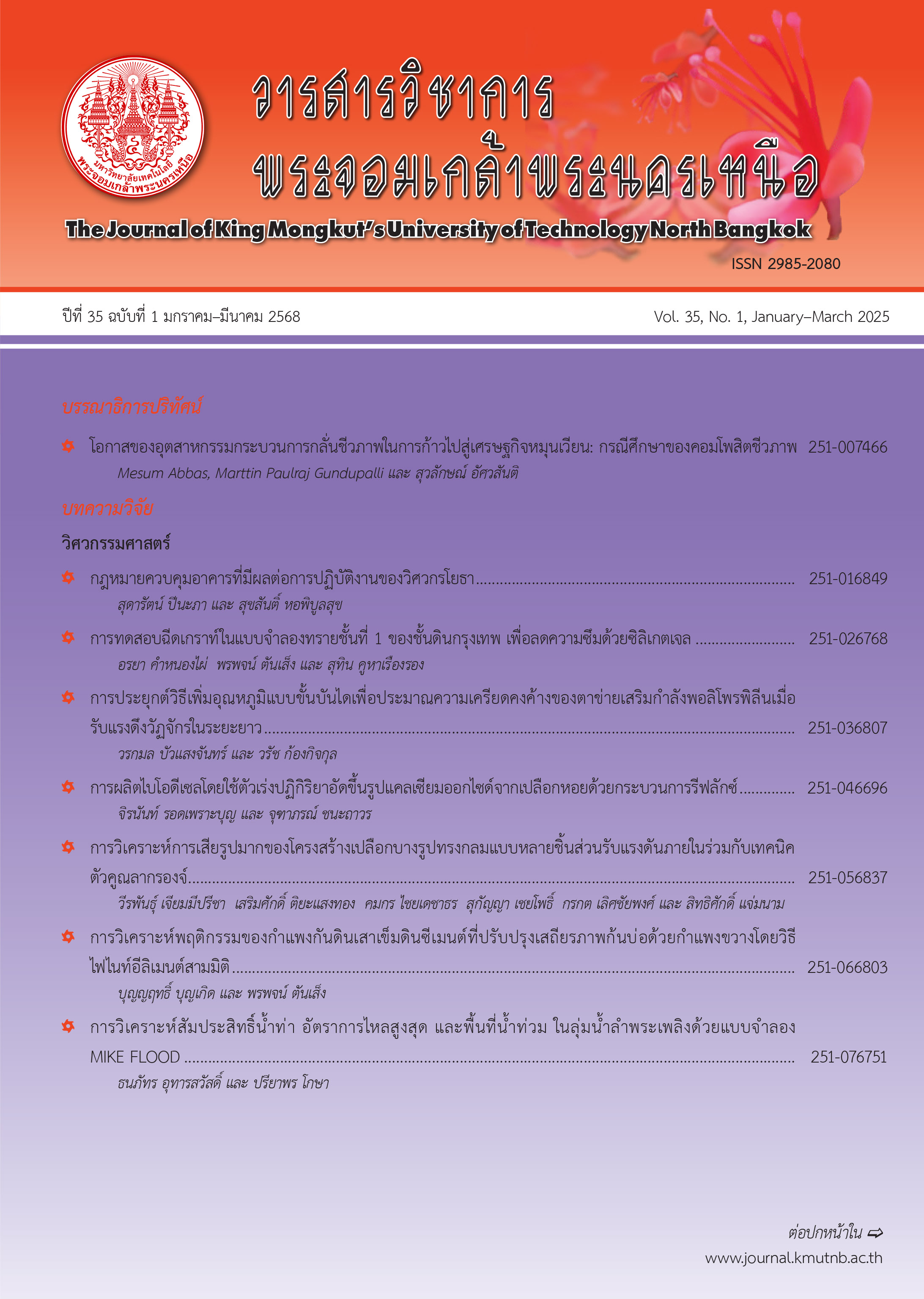การทดสอบฉีดเกราท์ในแบบจำลองทรายชั้นที่ 1 ของชั้นดินกรุงเทพ เพื่อลดความซึมด้วยซิลิเกตเจล
Main Article Content
บทคัดย่อ
บทความนี้กล่าวถึงการทดสอบการฉีดเกราท์ในแบบจำลองชั้นทรายของดินกรุงเทพชั้นที่ 1 เพื่อลดความซึมด้วยสารละลายโซเดียมซิลิเกตโดยวิธีอัตราการฉีดคงที่ มีวัตถุประสงค์เพื่อศึกษาถึงอิทธิพลของแรงดันและความหนืดของเกราท์ ที่ส่งผลต่อขนาดและรูปทรงของทรายที่ผ่านการเกราท์ ในทรายชั้นแรกของชั้นดินกรุงเทพการทดสอบใช้สารละลายโซเดียมซิลิเกตเป็นวัสดุในการเกราท์ โดยใช้ความหนืดเท่ากับ 110 เซนติพอยส์ และ 130 เซนติพอยส์ และใช้อัตราการฉีดเป็น 4.56 6.08 และ 7.60 มิลลิลิตรต่อนาที ผลการวิจัยพบว่า แรงดันในการเกราท์ส่งผลต่อรูปทรงของทรายที่ผ่านการเกราท์อย่างมีนัยสำคัญโดยแรงดันในการเกราท์ที่ต่ำส่งผลให้รูปทรงของทรายมีลักษณะเป็นทรงกลมรีสม่ำเสมอ การเกราท์จึงเป็นรูปแบบการเกราท์แบบซึม ในส่วนของความหนืดไม่ส่งผลต่อรูปทรงของทรายที่ผ่านการเกราท์ เนื่องจากความหนืดของเกราท์ที่ใช้ในงานวิจัยมีค่าใกล้เคียงกัน นอกจากนี้ทรายที่ผ่านการเกราท์ด้วยสารละลายโซเดียมซิลิเกตมีค่าสัมประสิทธิ์ความซึมต่ำลง 8.33 เท่า
Article Details

This work is licensed under a Creative Commons Attribution-NonCommercial-NoDerivatives 4.0 International License.
บทความที่ลงตีพิมพ์เป็นข้อคิดเห็นของผู้เขียนเท่านั้น
ผู้เขียนจะต้องเป็นผู้รับผิดชอบต่อผลทางกฎหมายใดๆ ที่อาจเกิดขึ้นจากบทความนั้น
References
Matichon Public Co.,Ltd. (2020, Jan.). Exploration of the construction underground site “Italian- Thai” MRT Orange line Thailand culture center – Min Buri. Bangkok, Thailand. [Online]. (in Thai) Available: https://www.prachachat.net/ property/news-411567
Matichon Public Co.,Ltd. (2021, Sep.). Implementation progress Tunnel of Bueng Nong Bon Construction on March 2022. Bangkok., Thailand. [Online]. (in Thai) Available: https://www.matichon.co.th/local/ new_2944429
T. Paveenchana and K. Saowiang, “The change of piezometric pressure in the subsoil strata affecting substructures in the Bangkok area,” in Proceedings of the Seminar of Soil Mechanics and Foundation Engineering, Bangkok, Thailand, 2012, pp. 1–12.
N. Phienwej, A. Asanprakit, P. Kittiyodom, and S. Timpong, “Increasing geotechnical challenges in the design and construction planning of the third phase Bangkok MRT underground,” in Proceeding of the 20th SEAGC, Indonesia, 2018.
Q. Wang, S. Wang, S. W. Sloan, D. Sheng and R. Pakzad, “Experimental investigation of pressure grouting in sand,” Soils and Foundations, vol. 56, no. 2, pp. 161–173, March 2016.
W. Wiriyatharakij, “MRTA station excavation under situation of space constraint and potential hydraulic uplift at base: cases of Sanamchai & Itsaraphap stations,” M.Eng. thesis, Department of Civil and Infrastructure Engineering, Asian Institute of Technology, 2016 (in Thai).
M. R. Hausmann, Modification at depth by grouting, Engineering principle of ground modification, Singapore, 1990, pp. 347–379.
C. Kutzner, “Grouting Theory,” Grouting of rock and soil, Rotterdam, Netherland, 1996, pp. 9–27.
Standard Test Methods for Specific Gravity of Soil Solids by Water Pycnometer, ASTM D 854-00, 2000.
Standard Test Method for Permeability of Granular Soils (Constant Head), ASTM D 2434- 68, 2000.
Standard Test Method for Particle-Size Analysis of Soils, ASTM D 422-63, 2002.
S. Lirer, A. Flora, M. Borrelli and A. Evangelista, “Modelling low pressure grouting of unsaturated silty sanda,” in Proceeding of the 5th International Conference on Ground Improvement Techniques, Kuala Lumpur, 2004, pp. 211–218.
